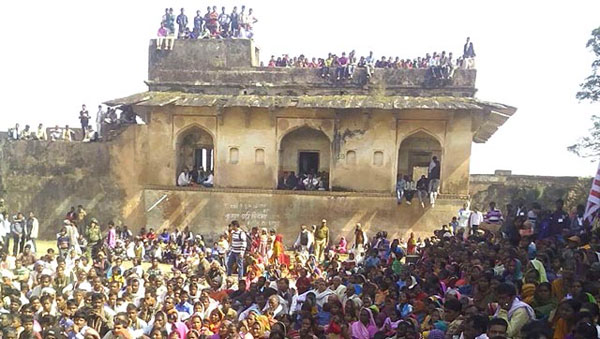Rohtasgarh Fort, Bihar: The Rashtriya Swayamsewak Sangh’s latest effort to make inroads among India’s tribal communities played out in Bihar’s most impoverished enclave on Sunday.
The Vanvasi Kalyan Ashram (VKA), an RSS affiliate, brought home the promise of development to tribals inhabiting remote, inaccessible villages around the Rohtasgarh Fort atop the Kaimur hills of western Bihar.
The fort, located about 200 km west of state capital Patna and just 170 km east of Prime Minister Narendra Modi’s Varanasi Lok Sabha constituency in Uttar Pradesh, is a pilgrimage centre for Oraons, Kharwars and Cheros among others.
These tribal communities believe the fort was once the seat of their rulers who held sway over large parts of India. Around this time of the year, they assemble at the fort from across the country to pay homage to their ancestors.
Getting to the fort is tough – it is located 1,500 feet above the sea level and the visitors have to walk 2 km on plains and climb a steep incline for another 3 km to reach it via Akbarpur, the last point till which a vehicle can go.
With basic facilities difficult to come by and schools and medical facilities even more difficult to access, few from the plains have been willing to give their daughters and sons in marriage to those residing in these inaccessible villages. In the absence of roads, women residing in villages on the Kaimur hills have to walk 8 to 10 km to fetch water.
Thanks to the inhospitable terrain, a deterrent for the police to visit this area, the fort had served as a Maoist sanctuary for long before it was ‘liberated’ by the security forces a few years ago.
As such, it was hardly surprising that no Union minister, or, for that matter even a Bihar cabinet minister, had ever visited the fort or the area around it since Independence.
All this changed on Sunday when RSS efforts saw as many as 3 Union ministers land at the Rohtasgarh Fort by helicopter to announce the arrival of development to this remote region.
At hand was a gathering of over 5,000 tribals from Bihar, Jharkhand, Orissa, Chhattisgarh, West Bengal and northeastern states, assembled for a ‘teerth Mela’ (pilgrimage fair) organised by the VKA.
Amid cheers from the crowd, Union tribal affairs minister Jual Oram announced the centre was in the process of clearing environmental hurdles to bring development to the doorstep of the forest people.
Oram also said Rohtasgarh Fort would be declared a national monument and all weather roads would be constructed to allow baraats or grooms’ parties to land at the doorstep of local villagers.
Minister of state for rural development Sudarshan Bhagat and minister of state for mines and steel Vishnu Deo Sai were also present to underscore the Modi regime’s ‘absolute commitment’ to tribals’ welfare.
However, much more than the spoken word it was the message implicit in the presence of the Union ministers – that they should have found it fit to travel to a place that few before them had, that appeared to move the crowd.
“Modi’s ministers’ presence at Rohtasgarh Fort has great symbolic value in that the tribals believe it was here that the last Chero king Hare Krishna was deceitfully defeated by Shershah Suri in 1539,” said Shyam Sunder Tiwary, a local historian.
He said five ‘karma’ trees worshipped by tribals stood even now on the fort premises.
“After the Chero king’s defeat, many local tribals shifted to different parts of country. But they return here this time of the year to pay homage to their ancestors. This is a great place to connect with them,” he said.
The visiting ministers appeared to be moved when local tribal women complained nobody was ready to marry their sons and daughters owing to inaccessibility of their villages in the absence of roads
“We do not get subsidised ration or kerosene and pregnant women die for want of medical care,” said septuagenarian Kamli not far from Burwan, which had gained notoriety for having the highest number of unmarried males.
“This is a fit place and occasion to express empathy with the tribal people drawn from all over India,” said VKA leader Mahang Oraon.
The VKA show at Rohtasgarh Fort came on the back of an RSS ‘baudhik’ (a way forward message) calling its volunteers to embrace Dalits, held at the nearby town of Bhabua last November.
At this event, a top leader had exhorted his audience to share food with Dalits so as to make them feel they were on an equal social footing with the rest of the Hindu society.

